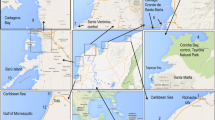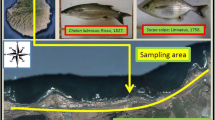Abstract
Sediments and fish, including tilapia (Oreochromis mossambicus), bighead carp (Aristichthys nobilis), grass carp (Ctenopharyngodon idellus), and mandarin fish (Siniperca chuatsi) were collected from different fish ponds in the Pearl River Delta (Tanzhou, Sanjiao, Guangzhou, Shipai, Changan, and Mai Po) for the analysis of metalloids and heavy metals [arsenic (As), cadmium (Cd), chromium (Cr), mercury (Hg), and lead (Pb)]. The pollution of As in pond sediments was great; however, As in the edible parts of pond fish were within the international permissible safety levels for human consumption. Axial muscles from 10 species each of freshwater and marine fish purchased from markets in Hong Kong were also analyzed for As, Cd, Cr, Cu, Hg, Ni, Pb and Zn. Freshwater fish contained 0.24 to 2.13 mg/kg As, 0.10 to 0.17 mg/kg Cd, 0.09 to 0.36 mg/kg Cr, 0.06 to 0.35 mg/kg Cu, 0.07 to 0.34 mg/kg Hg, 0.04 to 0.36 mg/kg Ni, 0.11 to 0.52 mg/kg Pb, and 2.67 to 19.1 mg/kg Zn (wet weight). Marine fish had higher Hg and lower Pb concentrations than freshwater fish. A few fish species had average concentrations greater than the international standards for Cd and Pb established by the European Union and the China National Standard Management Department. Total Hg concentrations in 10 of 20 market fish species were generally greater than those of the World Health Organization’s recommended limit of 0.2 mg/kg for at-risk groups, such as children and pregnant women. Daily intake through fish consumption of these metals were compared with the Provisional Tolerable Weekly Intake proposed by the Joint Food and Agriculture Organization/World Health Organization Expert Committee on Food Additives. There appears to be potential threat to local people from Hg contamination because of the high marine fish consumption rate (142 g/d/person).

Similar content being viewed by others
References
Aquaculture, Fisheries and Conservation Department (2006) Aquaculture: Technological development. Available at: http://www.afcd.gov.hk
Agusa T, Kunito T, Sufaryanto A, Monirith I, Kam-Atireklap S, Iwata H, et al. (2007) Exposure assessment for trace elements from consumption of marine fish in Southeast Asia. Environ Pollut 145:766–777
Andreji J, Stranai I, Kacániová M, Massányi P, Valent M (2006) Heavy metals content and microbiological quality of carp (Cyprinus carpio, L.) muscle from two Southwestern Slovak fish farms. J Environ Sci Health A - Toxic Hazard Subst Environ Eng 41:1071–1088
Australia New Zealand Food Authority (1999) Food Standards Code in the Gazette, Australia New Zealand Food Authority
Bervotes L, Blust R, Verheyen R (2001) Accumulation of metals in the tissues of three spined Stickelback (Gasterosteus aculeatus) from natural fresh waters. Ecotoxicol Environ Safe 48:117–127
Bloom NS (1992) On the chemical form of mercury in edible fish and marine invertebrate tissue. Can J Fish Aquat Sci 49:1010–1017
Comité Européen de Normalisation (1997) Wastewater treatment in the PRC Agriculture Department. PRC Agric Dep Environ Report 1(1):9–11
Chan KM (1995) Concentrations of copper, zinc, cadmium and lead in rabbitfish (Siganus oramin) collected in Victoria Harbour, Hong Kong. Mar Pollut Bull 31:277–280
Chen J (2006) Rapid urbanization in China: A real challenge to soil protection and food security. Catena 69:1–15
Chen TB, Wong JWC, Zhou HY, Wong MH (1997) Assessment of trace metal distribution and contamination in surface soils of Hong Kong. Environ Pollut 96:61–68
Cheung KC, Poon BHT, Lan CY, Wong MH (2003) Assessment of metal and nutrient concentrations in river water and sediment collected from the cities in the Pearl River Delta, South China. Chemosphere 52:1431–1440
China National Standards Management Department (2001) Safety qualification for agricultural product for non-environmental pollution aquatic products. GB 18406.4-2001. Beijing, China
Dickman MD, Leung KMC (1998) Mercury and organochlorine exposure from fish consumption in Hong Kong. Chemosphere 37:991–1015
Dickman MD, Leung CK, Leong MK (1998) Hong Kong male sub fertility links to mercury in human hair and fish. Sci Total Environ 214:165–174
Duzgoren-Aydin NS, Wong CSC, Song ZG., Aydin A, Li XD, You M (2006) Fate of heavy metal contaminants in road dusts and gully sediments in Guangzhou, SE China: A chemical and mineralogical assessment. Hum Ecol Risk Assess 12:374–389
European Union (2001) Commission Regulation As Regards Heavy Metals, Directive 2001/22/EC, No. 466/2001
Fabris G, Turoczy NJ, Stagnitti F (2006) Trace metal concentrations in edible tissue of snapper, flathead, lobster, and abalone from coastal waters of Victoria, Australia. Ecotox Environ Safe 63:286–292
Falcó G, Llobet JM, Bocio A, Domingo JL (2006) Daily intake of arsenic, cadmium, mercury, and lead by consumption of edible marine species. J Agric Food Chem 54:6100–6112
Food and Environmental Hygiene Department (2002) Chemical hazard evaluation. Dietary exposure to heavy metals of secondary school students. Volume 10B. Risk-assessment studies. Hong Kong Government, PRC
Fok TF, Lam HS, Ng PC, Yip ASK, Sin NC, Chan IHS, et al. (2007) Fetal methylmercury exposure as measured by cord blood mercury concentrations in a mother–infant cohort in Hong Kong. Environ Int 33:84–92
Goldstein GW (1992) Neurological concepts of lead poisoning in children. Pediatr Ann 21:384–388
Has-Schön E, Bogut I, Strelec I (2006) Heavy metal profile in five fish species included in human diet, domiciled in the end flow of River Neretva (Croatia). Arch Environ Contam Toxicol 50:545–551
Hong Kong Government (1987) Food Adulteration (Metallic Contamination) Regulations. Laws of Hong Kong 2, Chapter 132
Hong Kong Government (2004) Hong Kong Year Book. Chapter 9. Hong Kong Special Administration Region, China
Ip CCM, Li XD, Zhang G, Wong CSC, Zhang WL (2005) Heavy metal and Pb isotopic compositions of aquatic organisms in the Pearl River Estuary, South China. Environ Pollut 138:494–504
Ip P, Wong V, Ho M, Lee J, Wong W (2004) Mercury exposure in children with autistic spectrum disorder: Case-control study. J Child Neurol 19:431–434
Joint Food and Agriculture Organization/World Health Organization Expert Committee on Food Additives (1993) Evaluation of certain food additives and contaminants. World Health Organization Technical Report Series No. 837. WHO, Geneva, Switzerland
Joint Food and Agriculture Organization/World Health Organization Expert Committee on Food Additives (2003) Summary and conclusions of the 61st Meeting of the Joint FAO/WHO Expert Committee on Food Additives. JECFA/61/Sc, Rome, Italy 10–19 June 2003
Ko LYY (2004) A pilot study on the effect of heavy metal detoxification in children with chronic allergy. The 6th Asia Pacific Congress of Allergology and Chinical Immunology. Tokyo, Japan
Kong KY, Cheung KC, Wong CKC, Wong MH (2005) Residues of DDTs, PAHs and some heavy metals in fish (tilipa) collected from Hong Kong and Mainland China. J Environ Sci Heal A Toxic/Hazardous Substances and Environmental Engineering 40:2105–2115
Kuang W, Zhang D, Huang X (2005) Investigation and evaluation on heavy metal pollution of sediment in Shunde. Mod Prevent Med 32:807–809
Luckey TD, Venugopal B (1997) Metal toxicity in mammals. Plenum, New York, NY
Netherlands Ministry of Housing (1994) Dutch intervention values for soil remediation (report HQ 94-021). Environmental Quality Objectives in the Netherlands, Ministry of Housing, The Hague, The Netherlands
Ruddle K, Zhung KF (1988) Integrated agriculture-aquaculture in South PRC Agriculture Department: the Dike Pond System of the Zhujiang Delta. Cambridge University Press, Cambridge, MA
Shiomi K (1994) Arsenic in marine organisms: Chemical forms and toxicological aspects. In: Nriagu JO (ed) Arsenic in the environment. Part II: Human health and ecosystem effects. Wiley, New York, NY, pp 261–282
Sankar TV, Zynudheen AA, Anandan R, Viswanathan Nair PG (2006) Distribution of organochlorine pesticides and heavy metal residues in fish and shellfish from Calicut region, Kerala, India. Chemosphere 65:683–690
Storelli MM, Barone G, Garofalo R, Marcotrigiano GO (2007) Metals and organochlorine compounds in eel (Anguilla anguilla) from the Lesina lagoon, Adriatic Sea (Italy). Food Chem 100:1337–1341
United State Environmental Protection Agency (2000) Guidance for assessing chemical contaminant, data for use in fish advisories. Volume 2. Risk assessment and fish consumption limits, 3rd ed. Washington, DC
United State Environmental Protection Agency (2005) Risk-based concentration table, April, 2005. USEPA, Region 3, Philadelphia, PA. Available at: http://www.epa.gov/reg3hwmd/risk/human/rbc/RBCoct07.pdf
United States Food and Drug Administration (1993) Guidance documents for trace elements in seafood. Center for Food Safety and Applied Nutrition, Washington, DC
Waalkes MP (2000) Cadmium carcinogenesis in review. J Inorg Biochem 79:241–244
Wang X, Sato T, Xing B, Tao S (2005) Health risks of heavy metals to the general public in Tianjin, China, via consumption of vegetables and fish. Sci Total Environ 350:28–37
Wei TL, Yang WL, Lai ZN, Zhang Q, Liu M (2002) Residues of heavy metals in economic aquatic animal muscles in PEARL river estuary. South China J Fish Sci 9:172–176
World Health Organization (1990) IPCS environmental health criteria 101: Methylmercury. International Programme of Chemical Safety, World Health Organization, Geneva, Switzerland
World Health Organization (1995) Inorganic lead. Environmental Health Criteria, No. 165. World Health Organization, Geneva, Switzerland
Work Bureau (2000) Management of dredged/excavated sediment. WBTC No.3/2000. Hong Kong, PRC
Yang L, Fang Z, Zheng W, Wu Y (2002) Evaluation of heavy metals in edible fishes and bivalves available in a market in Guangzhou city [in Chinese]. Environ Sci Technol 25:15–16
Zang S, Shen Y, Wei I, Chen X (2005) Determination of Pb, Cd, Hg and As in Fish. Chinese J Spectro Lab 22:973–975
Zhang L, Wong MH (2007) Environmental mercury contamination in China: Sources and impacts. Environ Int 33:108–121
Zhou HY, Cheung RYH, Chan KM, Wong MH (1998) Metal concentrations in sediments and tilapia collected from inland waters of Hong Kong. Water Res 32:3331–3340
Acknowledgments
The authors thank C. Y. Lan and T. G. Luan of Zhongshan University and K. Y. Kong, I. Yeung, and C. W. Lau of Hong Kong Baptist University for their technical assistance. Financial support from the Faculty Research Grant, Science Faculty, Hong Kong Baptist University, is gratefully acknowledged.
Author information
Authors and Affiliations
Corresponding author
Rights and permissions
About this article
Cite this article
Cheung, K.C., Leung, H.M. & Wong, M.H. Metal Concentrations of Common Freshwater and Marine Fish from the Pearl River Delta, South China. Arch Environ Contam Toxicol 54, 705–715 (2008). https://doi.org/10.1007/s00244-007-9064-7
Published:
Issue Date:
DOI: https://doi.org/10.1007/s00244-007-9064-7




